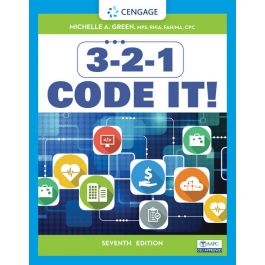Test Bank for 3 2 1 Code It! 7th Edition by Green
$35.00 Original price was: $35.00.$26.50Current price is: $26.50.
Test Bank for 3 2 1 Code It! 7th Edition by Green
Sell by: Brian Jacobs
SKU: yhjta475402
Category: Test Bank
Instant download Test Bank for 3 2 1 Code It! 7th Edition by Green pdf docx epub after payment.

1. A coder acquires a working knowledge of coding systems, coding conventions and guidelines, government regulations, and third-party payer requirements to ensure that documented diagnoses, services, and procedures are coded accurately for __________, research, and statistical purposes.
|
2. During internships (or professional practice experiences) at health care facilities, coding students receive __________ training.
|
3. Which is the person to whom the student reports at the health care facility internship site?
|
4. Which is the most likely reason a student would be terminated from the internship site, fails internship course, or suspended and/or expelled from the academic program?
|
5. Coders also have the opportunity to work at home for employers who partner with an Internet-based organization called a(n) __________, which is a third-party entity that manages and distributes software-based services and solutions to customers using the Internet.
|
6. Which professional is employed by third-party payers to review health-related claims to determine whether the costs are reasonable and medically necessary based on the patient’s diagnosis?
|
7. Students who join a professional association for a reduced membership fee often receive most of the same benefits as active members. Which is an example of a benefit of joining a professional association?
|
8. Which represents an online professional network about a variety of topics and issues?
|
9. Which organizes a medical nomenclature according to similar conditions, diseases, procedures, and services, and contains codes for each?
|
10. Which is a vocabulary of clinical and medical terms used by health care providers to document patient care?
|
11. Which includes numeric and alphanumeric characters that are reported to health plans for health care reimbursement, to external agencies for data collection, and internally for education and research?
|
12. Coding is the assignment of codes to diagnoses, services, and procedures based on __________.
|
13. Which is used to classify diagnoses in any health care setting?
|
14. Which is used to classify procedures in an inpatient hospital setting?
|
15. Which is published by the AMA and used to classify procedures and services in an outpatient setting?
|
16. Which is managed by CMS and used to classify medical equipment, injectable drugs, transportation services, and other services in an outpatient setting?
|
17. The Centers for Medicare & Medicaid Services (CMS) is a(n) __________ in the federal Department of Health and Human Services (DHHS).
|
18. Which is an example of a medical nomenclature?
|
19. The Health Insurance Portability and Accountability Act of 1996 (HIPAA) is federal legislation that amended the Internal Revenue Code of 1986 to __________.
|
20. The process of standardizing data by assigning alphanumeric values to text or other information is called __________.
|
21. The HIPAA small code set collects information concerning _____.
|
22. The HIPAA large code set collects information concerning _____.
|
23. HIPAA requires health plans that do not accept standard code sets to modify their systems to accept all valid codes or to contract with a(n) _____.
|
24. Which is an insurance company that establishes a contract to reimburse health care facilities and patients for procedures and services provided?
|
25. Which is an example of a third-party payer?
|
26. Which is an example of another health care professional who performs procedures or provides services to patients?
|
27. Which is another term for a health plan?
|
28. Adopting HIPAA’s standard code sets has improved data quality and simplified claims submission for health care providers who routinely deal with multiple __________.
|
29. A third-party administrator (TPA) is an entity that __________ and may contract with a health care clearinghouse to standardize data for claims processing.
|
30. The medical coding process requires the __________ of patient record documentation to identify diagnoses, procedures, and services for the purpose of assigning ICD-10-CM, ICD-10-PCS, HCPCS level II, and/or CPT codes.
|
31. Professional associations establish a code of ethics to help members understand how to differentiate between “right” and “wrong” and apply that understanding to __________.
|
32. Concurrent coding is the review of records and/or use of encounter forms and chargemasters to assign codes __________.
|
33. Which is used to record data about office procedures and services provided to patients?
|
34. Which contains a computer-generated list of procedures, services, and supplies and corresponding revenue codes along with charges for each?
|
35. Coders are prohibited from performing assumption coding, which is the assignment of codes based on assuming, from a review of clinical evidence in the patient’s record, that the patient has certain diagnoses or received certain procedures/services even though the __________.
|
36. When coders have questions about documented diagnoses or procedures/services, they use a physician query process to contact the responsible physician to __________.
|
37. Integrating the __________ physician query process with the electronic health record allows physicians to more easily receive and reply to queries, which results in better and timely responses from physicians.
|
38. A physician lists “viral pneumonia” as the final diagnosis. However, the coder notes that laboratory results state “gram-negative bacteria.” There is also documentation of chest pain, fever, and dyspnea due to pneumonia. What should the coder do?
|
39. The purpose of a clinical documentation improvement (CDI) program is to help health care facilities comply with government programs and other initiatives with the goal of improving health care quality. Thus, a CDI specialist initiates concurrent and retrospective reviews of inpatient records to identify __________ provider documentation.
|
40. A coding compliance program ensures that the assignment of codes to diagnoses, procedures, and services follows established coding guidelines, and health care organizations write policies and procedures to assist in implementing the coding compliance stages of __________.
|
41. An effective coding compliance program monitors coding processes for __________.
|
42. Computer-assisted coding uses software to automatically generate __________ by “reading” transcribed clinical documentation provided by health care practitioners.
|
43. A patient record is the business record for a patient encounter that documents __________.
|
44. Demographic data is patient identification information that is collected according to facility policy and includes information such as the __________.
|
45. The primary purpose of the record is to provide for __________.
|
46. A secondary purpose of the patient record is to __________.
|
47. Patient record documentation must be __________.
|
48. A teaching hospital is engaged in an approved graduate medical education __________ program in medicine, osteopathy, dentistry, or podiatry.
|
49. Residents are supervised by a(n) __________ physician during patient care.
|
50. Which type of physician participates in an approved GME program?
|
51. A hospitalist is a physician whose practice emphasizes providing care for hospital __________, and they are often internal medicine specialists who handle a patient’s entire admission process.
|
52. For medical necessity purposes, the patient record must support codes submitted for third-party payer reimbursement, and patient diagnoses must __________.
|
53. Which type of record is paper based?
|
54. Which type of record uses computer technology?
|
55. Patient records that consist of handwritten progress notes and automated laboratory results are an example of __________ records.
|
56. In a source-oriented record, reports are organized according to __________ in labeled sections.
|
57. Which is a systematic method of documentation that consists of four components: database, initial plan, problem list, and progress notes?
|
58. Chief complaint, social data, and past medical history are considered part of the problem-oriented record __________.
|
59. The table of contents for the problem-oriented record is called the __________, and it is filed at the beginning of the record and contains a numbered list of the patient’s problems, which helps to index documentation throughout the record.
|
60. The problem-oriented record __________ contains the strategy for managing patient care and any actions taken to investigate the patient’s condition and to treat and educate the patient.
|
61. Which is documented about each problem assigned to the patient, using the SOAP structure of the problem-oriented record?
|
62. To learn more about the patient’s condition and the management of the conditions, review the __________ plans in the problem-oriented record.
|
63. To determine how the patient will be informed about conditions for which he or she is being treated, review the __________ plans in the problem-oriented record.
|
64. To learn more about specific medications, goals, procedures, therapies, and treatments used to treat the patient, review the __________ plans in the problem-oriented record.
|
65. Observations about the patient’s physical findings or lab results would be found in the __________ portion of a problem-oriented SOAP note.
|
66. The patient’s statement about how he or she feels would be found in the __________ portion of a problem-oriented SOAP note.
|
67. The judgment, opinion, or evaluation made by the health care provider would be found in the __________ portion of a problem-oriented SOAP note.
|
68. Diagnostic, therapeutic, and education plans to resolve the problems would be found in the __________ portion of a problem-oriented SOAP note.
|
69. The progress notes section of the POR contains a(n) __________ note to summarize the patient’s care, treatment, response to care, and condition on release from the facility.
|
70. The progress notes section of the POR contains a(n) __________ note when the patient is relocated to another facility, and it summarizes the reason for admission, current diagnoses and medical information, and reason for relocation.
|
71. Integrated record reports are arranged in strict chronological date order (or in reverse date order), which allows for __________, and many facilities integrate only physician and ancillary services progress notes, which require entries to be identified by appropriate authentication.
|
72. The electronic health record is a(n) __________.
|
73. The electronic medical record is a(n) __________.
|
74. Document imaging supplements the EHR or EMR by scanning paper records so that they are __________.
|
75. Which is used during the document imaging process to create images of patient reports?
|
76. During the optical disk imaging process, each patient report is __________ with a unique identification number assigned by the facility.
|
77. Which is performed by health care facilities and providers for the purpose of administrative planning, submitting statistics to state and federal government agencies, and reporting health claims data to third-party payers?
|
78. Automated case abstracting software is used by hospitals to __________.
|
79. The UB-04 claim is submitted by __________ to health plans for reimbursement purposes.
|
80. The CMS-1500 claim is submitted by __________ to third-party payers for processing.
|
81. Medical management software is used to _____.
|
Match each statement of purpose with the reference/resource listed below.
|
82. Medicare regulations (Centers for Medicare and Medicaid Services)
|
83. Software used by hospitals to help identify CPT/HCPCS coding errors
|
84. Monthly newsletter published by AMA as an official coding resource
|
85. Quarterly newsletter published by AHA as an official coding resource
|
86. Code edits pairs” that cannot be reported on the same claim for payment
|
Match each illegal coding practice with the correct term listed below.
|
87. Reporting multiple CPT codes to increase reimbursement when a combination code should be reported
|
88. Reporting codes for associated signs and symptoms in addition to an established diagnosis
|
89. Routinely assigning lower-level CPT codes as a convenience instead of reviewing documentation and the coding manual to determine the proper code to be reported
|
90. Routinely assigning an unspecified ICD-10-CM disease code instead of reviewing the coding manual to select the appropriate code number
|
91. Reporting codes that are not supported by documentation in the patient record for the purpose of increasing reimbursement
|
Match each credential with the corresponding credentialing organization listed below.
|
92. CCS
|
93. CMA
|
94. CPC
|
95. CMRS
|
Match each description with the type of code set listed below.
|
96. Actions related to disease impairment management, prevention, and treatment
|
97. Causes of injury, disease, impairment, or other health-related problems
|
98. Diseases, injuries, impairments, other health-related problems and their manifestations
|
99. Race, ethnicity, type of facility, and type of unit
|
100. Substances, equipment, supplies, or other items
|
101. Which provides normalized names for clinical drugs and links its names to many of the drug vocabularies commonly used in pharmacy management and drug interaction software?
|
102. Which classifies health and health-related domains that describe body functions and structures, activities, and participation and complements ICD-10, looking beyond mortality and disease?
|
103. Which was implemented in 2001 to classify a tumor according to primary site (topography) and morphology (histology, behavior, and aggression of tumor)?
|
104. Which is published by the American Psychiatric Association and contains diagnostic assessment criteria used as tools to identify psychiatric disorders?
|
105. Which provides a new standardized framework and a unique coding structure for assessing, documenting, and classifying home health and ambulatory care?
|
106. Which is an electronic database and universal standard that is used to identify medical laboratory observations for the purpose of clinical care and management?
|
Related products
Sale!
Sell by: Spencer Lowe
Sale!
Sell by: Chloe Roberts
Sale!
Sell by: Madison Foster
Sale!
Test Bank
Test Bank for Essentials of Business Law and the Legal Environment, 11th Edition: Richard A. Mann
Sell by: Kevin Murphy
Sale!
Test Bank
Test Bank for Decision Support and Business Intelligence Systems, 9th Edition: Efraim Turban
Sell by: Andrew Walker
Sale!
Sell by: Hannah Edwards
Sale!
Sell by: Anthony Campbell
Sale!
Sell by: Hunter Wallace











